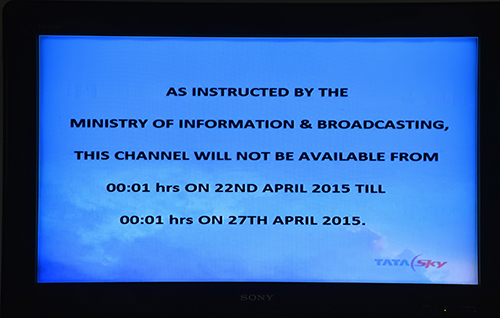On Wednesday, Al-Jazeera was forced off the air in India after the government demanded the Qatar-based news broadcaster be suspended for five days for broadcasting images of maps between 2013 and 2014 that did not display Pakistan-controlled Kashmir as separate territory.
On Wednesday, cable viewers trying to watch Al-Jazeera in India were greeted with a notice that read: “As instructed by the Ministry of Information and Broadcasting, this channel will not be available from 00.01 hours on 22nd April till 00.01 hours on 27th April 2015,” The Times of India reported. The news outlet’s website is still accessible in India.
The Times reported that the ban was ordered after the Ministry of Information and Broadcasting “said that it had come to its notice that Al-Jazeera had shown a wrong map of India in some of its broadcasts in 2013 and 2014, after which the matter was referred to Surveyor General of India.”
In a statement responding to the move Al-Jazeera said its executives wanted to meet with the government to discuss not just the ban, but “a series of ongoing issues.” The statement added: “We have though been severely hampered for too long by constraints placed upon us when trying to tell Indian stories to the world.” The broadcaster added that it corrected its maps, which it had bought from an outside provider, when the complaint was first raised in 2014.
For the past couple of years, CPJ’s Asia research associate Sumit Galhotra has been writing about the government’s attempts to bring the domestic media more under its control–see his most recent piece “Challenges for India’s press increase as Modi marks first year in office” and an earlier piece, “Worrisome curbs on free speech emerge since Modi’s election.” Over the years, CPJ has recorded instances of harassment of foreign media in India, but the brunt of the government’s anger appears to have been directed at local media.
Television broadcasters have been given punishments similar to that given to Al-Jazeera, but usually for airing what the censors consider salacious content. For example, the privately owned channel Satlon News TV, based in Gujarat, was ordered off air for 30 days from April 15 over a news item that contained nude visuals of a TV actor, according to the English language daily, The New Indian Express. And the frank discussion of violence against women in India’s Daughter, a BBC documentary about a notorious gang rape, led to a ban on the program being aired in India in March.
At first blush, the issue of how to represent maps of the border area with Pakistan, delineating Pakistan-controlled Kashmir as separate territory, might seem mundane. But the question, especially given the hostile relations between the two countries, is a long-standing issue. Since August 1947 the countries have fought three major wars and one minor war over territorial disputes including Kashmir. In 2010, the Indian government forced the Economist to place stickers over a map showing Kashmir in about 30,000 copies of the magazine before it could be distributed in India, according to reports.
As someone who watches South Asia politics fairly closely I have to wonder, given the recent step up in tension between India and Pakistan and others in and around the Indian Ocean, whether this isn’t just international grandstanding. That, plus a way of getting back at a nettlesome international news organization that doesn’t always portray India in the most flattering light.
